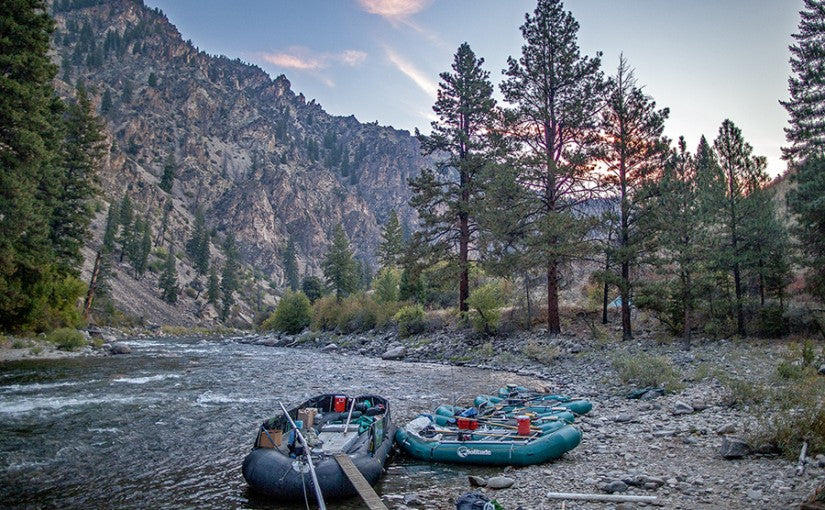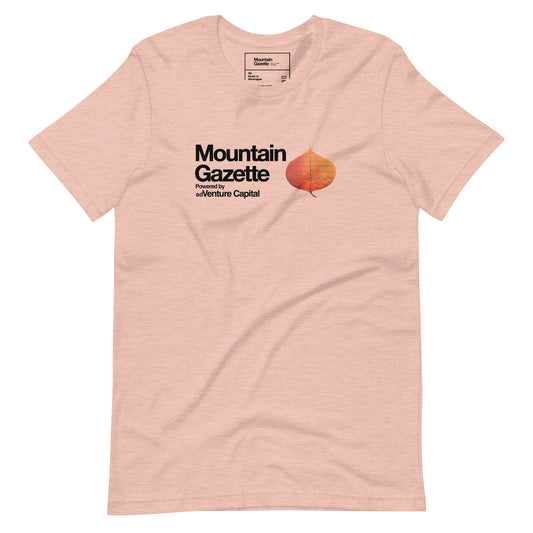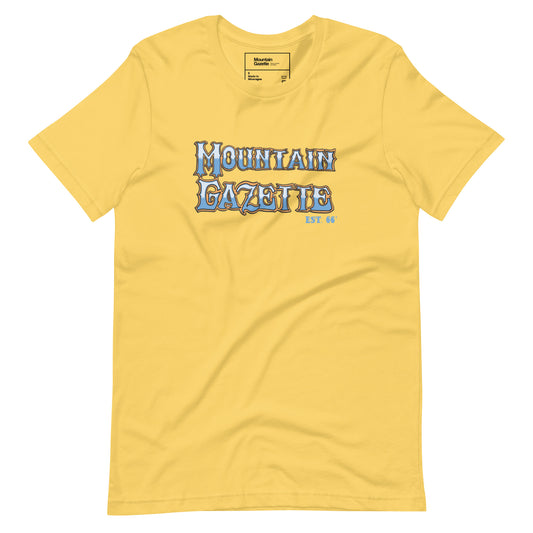One man’s determination to run the Middle Fork of the Salmon in his kayak turns into a story of mermaids, fly fishing, punishment, and camaraderie. By Nicholas O’Connell

It’s a rock dodge. I point the red 9-foot kayak toward Orelano Rapid on the Middle Fork of the Salmon River in Idaho. The rapid is rated a III (on a scale of I – VI, from easy to hazardous), putting it at the limit of my abilities as a kayaker. Earlier rapids have boosted my confidence, but I hope they haven’t lulled me into a false sense of security.
I enter the rapid on the right, weaving past one rock and then another, relishing the feeling of dashing through the whitewater. A boulder looms ahead. I glide past it, but overcompensate, turning my kayak to the side. The current smashes it against a large boulder, high-centering it on the top. I dig on the paddle, trying to free it.
As I try to shove off, the current catches the underside of the kayak, flipping me into the drink. The water is cold, fast, and powerful. I clutch the boat and pin the paddle between my knees. The river surges past me, threatening to knock me over. I remember the guide’s advice about staying calm, facing down river and releasing the boat if necessary, but I keep fighting and drag it over to the bank. Taking a moment to catch my breath, I assess the situation.
For years, I’ve wanted to run the Middle Fork and experience every riffle and rapid of this wild and scenic river. Despite the spill, I’ve progressed with my paddling and hope to develop some decent chops during the trip. Easing myself back into to the kayak, I shove off and re-enter the current. I steer more decisively, avoiding the last boulders and gliding into the smooth water below.
“Nice job!” says Willi Cannell, owner of Solitude River Trips, as he pulls up next to me in the larger raft. “That’s what we call an unscheduled swim.”
The “unscheduled swim” serves as my baptism by whitewater on the Middle Fork of the Salmon River, one of the premier multi-day whitewater trips in the world. It’s the first day of our 77-mile, six-day journey. My friend, Chris Olsen, an avid river rat, and five others make up our group of seven. With its abundant whitewater, outstanding fishing, and fascinating native pictographs, the trip represents an intact fragment of the American West.
“It never gets old,” says Willi, 28, a calm, bearded guide who has run the river some 70 times. “I notice something new every time.”
The river begins high in the Sawtooth Mountains near Stanley, Idaho, north of Boise, Idaho. It runs fast and hard for its length of some 100 miles, passing through the Frank Church-River of No Return Wilderness Area which contains one of the deepest canyons in the continental United States. At 7,000 feet of relief, it’s almost as deep as the Grand Canyon. At 2.367 million acres, it’s the largest contiguous wilderness in the lower 48. Rafting the Middle Fork is the most spectacular way to explore it.
At the end of the first day, my arms ache, but I’m pleased with my progress. I navigated a number of moderate rapids without taking another “unscheduled swim,” as Willi would put it. An enthusiastic teacher, he coached me through each of them, describing the easiest line and then leading the way with the raft.
Chris and I steer the kayaks into camp and pull them up onto the rocky shore. The guides have set up tents for us on a grassy ledge. All we have to do is assemble our cots and lay out our sleeping bags. I feel guilty about not doing more, but the guides are a cheerful, well-oiled machine, now busy preparing a fried chicken dinner. So I grab a cold beer, sit in a lounge chair and watch the river run by.
We chat with the others about the first day. Charles Gehr, an expert fly fisherman from Ashland, Oregon, swaps fish tales with Orville and Vince Talbert and Katie Peterson, vacationing from Maryland. We have no cell reception. No television. No contact with the outside world. We’re back to the pleasures of storytelling.
SWIMMING WITH MERMAIDS
After breakfast the next morning, I shove off, eager to test my paddling skills. Chris and I warm up on a couple easier rapids before hitting Jackass Rapid (Class III). Willi gives us advice about running it.
“Hug the side along the gravel bar and then go left,” he says, above the roar of the rapid.
He goes first. I watch him maneuver the raft through it and then follow. The current pushes me left and I go with it until I whip past the gravel bar. I dig hard on my right to avoid getting smashed into the ledges. The kayak pivots left and bursts into the wave train below. Pleased with this accomplishment, I raise my paddle in celebration.
Turning around, I see Chris entering the rapid. He steers toward the gravel bar, but doesn’t paddle quickly enough to clear the rapid on his right. The wave engulfs his kayak, which disappears beneath him. The current spews him into the eddy below.
“The mermaids got me!” he says, grinning. “They pulled me under.”
The mermaids appear to be active today. With his unscheduled swim, Chris and I head downriver, gaining confidence with every rapid. The kayaks travel much faster than the larger rafts, so we wait in an eddy until the rest of the group catches up with us.
“Are you enjoying the kayak?” asks guide Adam Grogan.
“It’s great fun,” I say.
“Watch out for Killer Fang Falls,” he says ominously. “Only one man has survived it. May the force be with you!”
I easily navigate the rest of the rapids and Killer Fang Falls never materializes. The force appears to be with me today.
Later in the evening, I ask Willi for a lesson in fly casting. I have fly fished before, mostly in my teens, and would love to try it again.
Willi demonstrates how to cast. “Remember to take the line back as far as you throw it forward,” he says. “The line will send the fly out.”
He hands me the rod. My first few casts are messy and awkward, the line snaking around and hitting the water in back of me. Then I allow the line to go back far enough to launch it forward. After a few times, I fling the line forward into the current.
I get a couple bites and then—Wham—something grabs the fly. The rod bends double as I madly try to bring in line and keep the rod tip high. The fish works back and forth across the river, trying to throw the barbless hook. I try to bring in line, but the fish keeps fighting. Slowly, I bring it closer.
“Willi, can you help me land it?” I excitedly move it toward the shallows. Willi comes over, takes the line, and guides the fish into the sand. It’s a beautiful 14-inch native cutthroat, a great omen for the trip ahead.
“Nice job!” Willi says as he removes the hook and releases the fish. With a flick of its tail, it disappears into the current. There’s nothing like a catching a large trout to stoke fishing fever.
READING THE RIVER
The next day, I trade places with Vince. He wants to try the kayak, while I’m psyched to fly fish, another way of reading and experiencing the river. I hope to avoid hooking Charles or guide Roger Goth and perhaps even catch a fish in the process.
Just watching Charles improves my own casting. His cast is fluid and stylish. Roger rows back and forth across the river to put us on the best fish habitat.
We cast into the banks, landing our flies in the seams alongside the main current where the fish congregate. The idea is to put the fly, a dry attractor pattern, right above the trout’s nose. I sometimes hit and sometimes miss the mark, but either way the trout don’t seem impressed.
Charles makes a cast, watches it drift, and then reels in his line. “That fish came up, looked at it, gave me the fin and then swam away,” he says, shaking his head.
We pass through prime fishing water, the river rushing past huge pink granite boulders. I’m expecting a strike but it doesn’t come. Fishing is about belief; you have to believe the fish will take your fly.
Fifteen minutes from camp, I cast again, sending the line out in a curving S-shape, the fly lightly landing on the surface. Bright and buoyant, it rides through the seam. A fish engulfs it. I pull back on the rod, hooking the fish.
“You’re going to have to net it yourself,” Roger says. “I need to steer.”
A small rapid looms ahead. I keep reeling and hold up the rod as we head through the rapid. At the end of it, I reel in the line and feel the fish struggling to throw the hook. I bring it toward the raft until Roger nets it, a beautiful 14- inch native cutthroat, wriggling and flapping. I take a long look at the fish: its green, black-spotted back, bright red slashes along its jaw, and fierce, surprised eye. Then Roger drops it back in the water.
Late in the afternoon, we pull into Grassy Flat, a wide open field above the river bordered by a grove of ponderosa pine trees. The guides have already set up the tents among the trees. Like all the other campsites, this one looks as pristine as when Lewis and Clark passed through the region in 1805, avoiding the Salmon River as too tough to navigate. No garbage. No pop cans. Not even a fire ring. The guides bring a portable metal fire box for cooking. It feels like we’re the first ones to visit this place.
“I’m jealous of people who come down the river for the first time,” Willi says over a beer. “I love to hear people say, ‘It’s amazing this place exists in the lower 48.’”
The next day, we take out the kayaks again. The rapids will be challenging, but Willi is confident in our abilities. By this time, my paddling skills have improved, but the volume of water has increased. At the start of the trip it was low and “bony,” but now it’s broad, flat, and powerful, barreling around rocks, making the hydraulics more challenging.
After we run a couple riffles, Willi announces that Waterfall Creek Rapid (Class IV) is coming up. “It’s complicated and technical,” he adds. “You’ll start to the right, go left, and then back to the right.”
The roar of the rapid is deep and powerful. Chris and I wait in our kayaks until Willi’s raft hits the rapid on the right. Willi skillfully pivots the raft to the left, churning through the whitewater. Then he brings it back to the right, the water surging around him.
Chris is right behind him, fighting his way through the rapid. I back paddle, waiting my turn. I don’t want to enter too soon and crash into Chris. He disappears into the rapid. I can’t wait any longer; I don’t want to lose sight of him. I head for the right side of the rapid, feeling it buffet the kayak. I spot Chris and stroke right, turning my kayak until—Whoa! —I plunge over a drop into the pool below. Cursing, I fight hard to follow him as he bobs and weaves through the waves. The current knocks me around like a bathtub toy, but I keep moving left, following a path through the tumult, the current shoving me toward a large granite boulder, threatening to high-center me like at Orelano Rapid, but I stroke madly, just missing it. I spot a chute amid the spray and go for it, shooting through it like a grapeseed through fingers. Waves smack me from both sides, trying to wrest the paddle from my grasp. I grit my teeth, clench my paddle and take my punishment.
The river releases me into the calm water below. I execute a wide pirouette, catching my breath and feeling the knot in my stomach release.
Chris raises his paddle in the air. I do the same. I let out a yell, jazzed by the jolt of adrenalin.
That evening we camp at Ouzel, a narrow strip of sand on the bank. It’s our last night and everyone’s in a celebratory mood. The guides serve London Broil steak and pop the corks on several bottles of wine. Sitting by the river, I take in the beauty of the surroundings: the broken line of cliffs on the opposite bank, the bright half moon rising in the distance, the chorus of crickets and frogs serenading us. Later that evening, guide Charles Baker takes out his guitar and sings “Old Crow Medicine Show” with the Milky Way overhead, his voice harmonizing with the river murmuring in the background.
PAGES OF STONE
On the last day, Willi says the rapids are “consequential” and so we put away the kayaks and board the rafts for the final leg of the trip. I’m alternately disappointed and relieved not to be running these rapids in a kayak, but it’s a moot point. Willi has spoken.
0E4A8152_4748Right after breakfast, we pull in at the Stoddard Creek. After a short walk, we reach an extensive series of pictographs drawn by the Sheepeater Indians who lived in the Middle Fork canyon for centuries. The drawings depict deer, elk, and the stick figures of those who preceded us.
Getting back on the rafts, we barrel through some of the biggest rapids on the river—Rubber, Devil’s Tooth, House of Rock. In between rapids, I stare up at the steep rock walls of the Impassable Canyon, awed by the intricate patterns and whorls of minerals. It’s the history of the Middle Fork written in pages of stone, a history unfathomably long, complex and mysterious, with human life just the last brief page.
The Greek philosopher Heraclitus observed that you never experience the same river twice. This has certainly been true of this trip. Every day has brought new sights, sounds, smells, tastes, textures, and experiences: the exhilaration of the rapids, the satisfaction of learning to run them, the camaraderie of the group, the graciousness of the guides, all wrapped up in the powerful and haunting rhythms of the river.
As we approach the confluence with the main Salmon, I marvel at how quickly the time has passed. Then I spot a dirt road, the first real sign of development in the last week. As we haul our gear up to the take out, a trio of ORVs roars by, welcoming us back to “civilization.”
Nicholas O’Connell is the author of The Storms of Denali and teaches for www.thewritersworkshop.net.
TOP PHOTO courtesy Solitude River Trips; ALL OTHER PHOTOS by Kat Smith.



